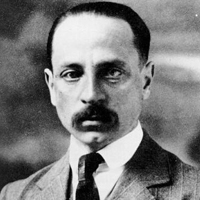Rainer Maria Rilke - Biography and Works
Rainer Maria Rilke (1875-1926) was an Austrian lyric poet, born in Bohemia. He studied at Prague, Munich and Berlin.

Rainer Maria Rilke
His three part poem cycle, The Book of Hours (1905), written after his visits to Russia (1899-1900), presents the perspective of a Russian Monk. Rilke’s conception of art as a quasi-religious vocation culminated in the hymn lyrics for which he is best known: The Sonnets to Orpheus and Duino Elegies, both written in 1923, in which he sought to define a poet’s spiritual role in, the face of transience and death.
In September of 1905, the famous French sculptor Rodin offered Rilke a job as his secretary. Rodin taught him a great deal. For an artist, Rodin said, the thing is not dreaming or talking, but work. When Rilke confided one day that he had not been writing lately, Rodin suggested that Rilke go to the zoo. “What shall I do there?” asked Rilke. And Rodin said, “Look at an animal until you see it. Two or three weeks might not be too long.” Rilke chose a panther, and wrote this celebrated “seeing” poem (1927) which imitates in its sound the panther’s walks.
Rilke’s poem, "Panther", depicts the picture of a panther locked in a cage inside the zoo:
“His vision, from the constantly passing bars,
has grown so weary that it cannot hold
anything else. It seems to him there are
a thousand bars; and behind the bars, no world.
As he paces in cramped circles, over and over,
the movement of his powerful soft strides
is like a ritual dance around a center
in which a mighty will stands paralyzed.
Only at times, the curtain of the pupils
lifts, quietly -. An image enters in,
rushes down through the tensed, arrested muscles,
plunges into the heart and is gone.”
